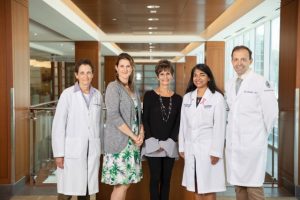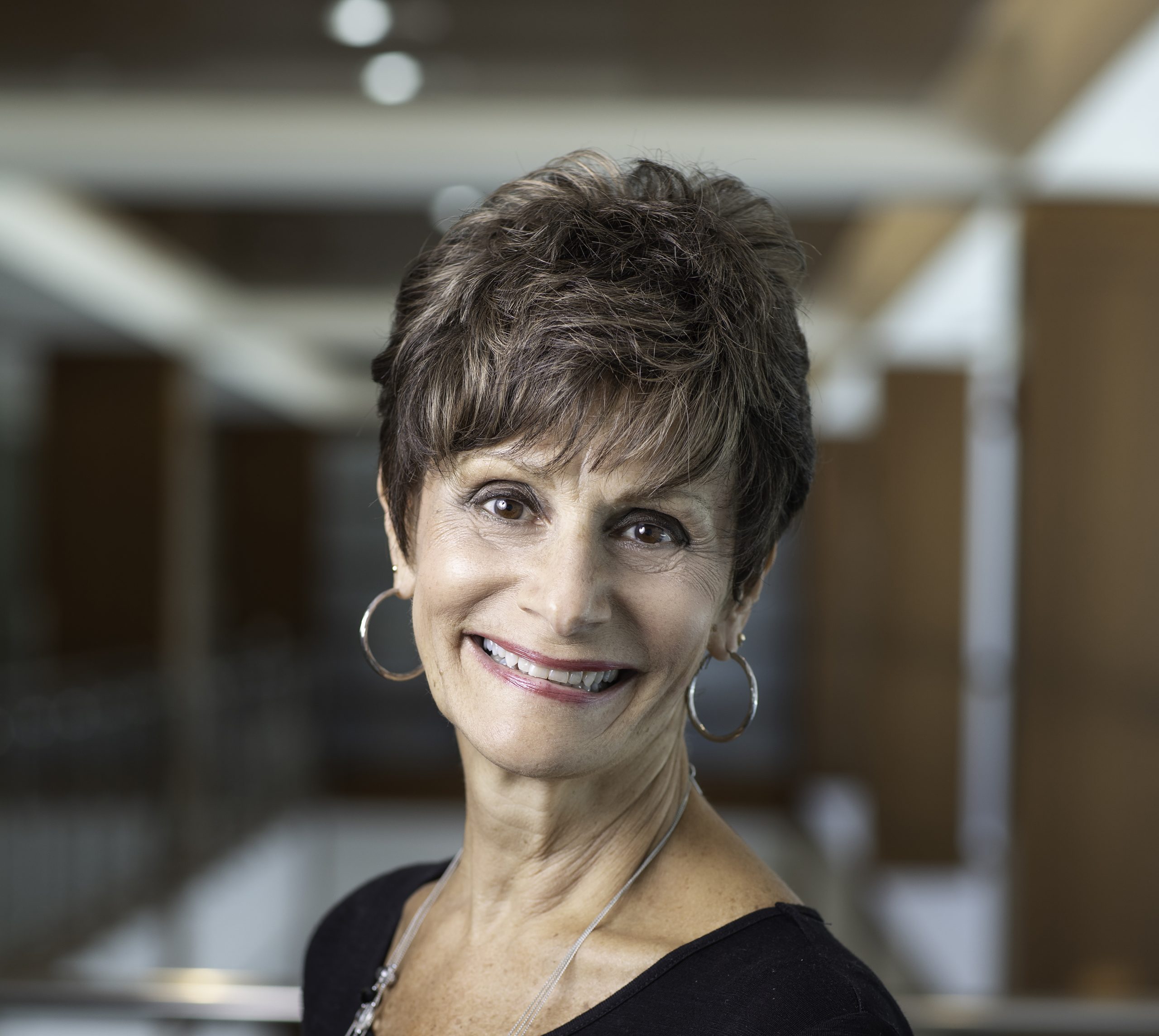Ask any woman who’s had a breast cancer scare to describe the terror she goes through waiting for the outcome of a suspicious mammogram or a discovered breast lump, and she’ll tell you that a huge percentage of that nightmare is waiting for results, which can take days or even more than a week.
Not so at UConn Health, where the Breast Program team at its Carole and Ray Neag Comprehensive Cancer Center has taken the diagnosis and treatment modality wait to a tornado-like level; it often takes as little as one day for women to get results and be placed in a care plan that rapidly places them on the road to recovery. “Recovery” is the operative word among members of this breast health team, according to legions of patients with remarkable survivor outcomes. You might say this team has made a science out of expediency.
“Molly Tsipouras and Dr. Christina Stevenson are really the doors into the program,” explains Dr. Susan Tannenbaum, Chief of the Division of Hematology-Oncology at UConn Health. Molly is Margaret Tsipouras, R.N., B.S.N., O.C.N., CPBN-IC, who carries the title of breast oncology nurse navigator. Dr. Stevenson is both a breast surgeon and Director of the Breast Program, a title she earned 18 months ago.
“Molly has created an incredible relationship with our primary care providers – OB/GYN and internal medicine physicians. She’s made it extremely easy to take the ball and run with issues when physicians call and express concern over patient problems,” Dr. Tannenbaum says.
In her 20/20 hour week, Tsipouras devotes half of her time to working with Dr. Aleksey (Alex) Merkulov – “the best breast imager that I know,” says Dr. Tannenbaum – and the other half with Dr. Stevenson, making sure that women are moved efficiently through the system and that the team has addressed patients’ psychological and financial concerns.
Tsipouras was the first of UConn Health’s four-member nurse navigator team, initiating the navigation process six years ago. The goal was to take the red tape out of the cancer recovery process by enabling physicians to get their patients’ biopsies, imaging, and other tests done quickly. To do so, Dr. Stevenson and Tsipouras made a conscious effort to visit OB/GYN and primary care physicians, explaining the role of the nurse navigator. “We told them that if they had a patient that needed to be seen, we ask that they please call, please call, please call,” says Tsipouras.
“With our newly launched electronic medical record HealthONE, we’re now able to assure that all patients have an expedient way of getting into the system and that all tests are ordered. Today, physicians don’t hesitate to reach out via phone, email or texts.”
As an example of how an expeditious system can work, Dr. Tannenbaum references patient Lynn Killingbeck (see related story).
“First, Lynn’s primary care physician found a mass in her left breast, after which she contacted our breast health team. Then Molly got Lynn in to see Dr. Stevenson, who then ordered more imaging via Dr. Merkulov. That was followed by a biopsy, which led to lumpectomy surgery.
The entire process only took days, rather than weeks,” says Dr. Tannenbaum.
Another essential component of the Breast Program includes appropriate patients going through UConn Health’s Genetics Program, where they see certified genetic counselors to discuss possible familial or genetic predisposition for developing breast cancer.
ACCURACY IS KEY
While expediency is an integral part of relieving women – and in one percent of breast cancer cases, men – from the stress and angst associated with awaiting test results, the accurate assessment of test results is equally essential.
This is where Dr. Merkulov continues to play a key role in the Breast Program. He’s responsible for bringing tomosynthesis technology, commonly referred to as 3-D mammography, to UConn Health.
Dr. Tannenbaum shared, “When Alex came to us, he said, ‘We have to bring this technology (tomosynthesis) into UConn,’ and six years ago, we became the first in the Hartford region to get it.”
Praising the virtues of tomosynthesis, Dr. Merkulov says this technology helps eliminate errors. “If you see some things that aren’t factual – possibly not real – you can use 3-D mammography to make sure it’s really not real. We can give women a definitive answer, thereby reducing the number of women who get scared with bad news.”
Comparing today’s breast cancer technology to as recently as six years ago, it’s “the difference between night and day,” he says. With tomosynthesis technology, “the specificity is higher, meaning that the accuracy of the test is higher. We also have high-end ultrasound equipment; if we’re not sure of something, the quality of the ultrasound is important.”
Today, about 10 percent of women are called back for these additional tests following a mammogram, a number that has not changed over the years. The cancer team explains that everything plays a factor in recall – including age and a woman’s time of the month.
The belief that, as women age, they are more prone to recall is a fallacy. “Quite the opposite is true,” says Dr. Merkulov. “It’s easier to see tumors in older women than in younger ones. That’s why younger women are usually the ones who benefit from newer technology.”
The diagnosis pathway used is that ultrasound follows mammogram, if needed, “especially if one has very, very dense breasts. So women in Connecticut [as part of state law] are allowed to have ultrasound as an adjunct test in the setting of dense breasts,” Dr. Merkulov explains.
Additionally, UConn Health’s 3-D test is a diagnostic part of an annual mammogram, which made the healthcare center unique for a number of years before other institutions started introducing 3-D technology, according to Dr. Tannenbaum.
“We try to use 3-D technology appropriately. You don’t want to under- or over-use it, because sometimes, as with any technology, it can cause confusion. It’s like a skill; you have to know precisely how to use it,” Dr. Merkulov says.
The team also employs an implantable device called a BioZorb – “a new, absorbable device that acts as a scaffold for tissue regrowth, intended to improve the precision of radiation treatments,” says Dr. Stevenson.
A BioZorb is a small, three-dimensional marker used in women with early-stage breast cancer. It provides a target for aiming radiation therapy at the tumor site, which helps minimize damage to healthy tissue among the 120,000 women in the United States diagnosed with early-stage breast cancer annually, and who undergo a lumpectomy – also called breast-conserving surgery – with radiation.

AN INCREDIBLE TEAM
Before one reduces UConn Health’s success to speed and technology, Dr. Tannenbaum is quick to point out that “it comes down to the people. You have the machines and the technology, but it comes down to professionals such as Dr. Merkulov and Dr. Stevenson who have the skill set. They’re pretty remarkable.”
Supporting this position are UConn Health’s post-surgical results, which have become significantly improved, thanks to Dr. Stevenson’s work. Patients have been extremely pleased with their results.
“She (Dr. Stevenson) could have been a plastic surgeon. There’s hardly any scar following my surgery!” Killingbeck says.
Dr. Tannenbaum points out that, “As important as Dr. Stevenson’s reputation is for leaving small scars, her judgment and the way she performs surgery is just as important.”
Dr. Stevenson is specially trained in what’s known as oncoplastic surgery outcomes. Her technique includes trying to “maintain the shape and size of the breast as best we can.”
As a surgical oncologist, Dr. Stevenson sees 70-100 cancer patients a year and four times that amount of benign breast conditions. Her extensive training includes oncoplastic surgery, which combines the latest plastic surgery techniques with breast surgical oncology. Oncoplastic techniques apply when a large lumpectomy is required that will leave the breast distorted; the remaining tissue is sculpted to realign the nipple and areola and restore a natural appearance to the breast shape.
“It used to be that following a lumpectomy, the patient would have a big divot where tissue was removed,” Dr. Tannenbaum explains. “Now, we [use] special techniques to manipulate some of the tissue below the surface to prevent that divot so there is no defect, post-op. You can’t see where the lump has been removed.”
“Dr. Stevenson has very few complications following her surgeries,” adds Dr. Merkulov, “and that’s an important thing to remember. Sometimes a surgeon gets into a procedure and 20 times the problems can arise, but her skill set has minimized these complications.”
What goes into great judgment when it comes to breast surgery?
“Dr. Stevenson knows when there are procedures that do and don’t need to be done. She’s outstanding in sampling sentinel nodes and knowing when she needs to move forward with a further lymph node dissection,” says Dr. Tannenbaum. She explains that many patients will require systemic therapy – chemotherapy, biologic therapy, and/or hormonal therapy – before or after surgery, which the team decides together. Tannenbaum, as the medical oncologist, delivers these treatments.
Radiation is also crucial for controlling the disease so there are no recurrences, and Dr. Robert Dowsett, Chief of UConn’s Division of Radiation Oncology, is the expert in that field. He has brought in new technology to reduce the radiation delivered to the heart as well as to shorten times needed for radiation.
“Again, it’s all about the terrific team we have, which includes a multidisciplinary approach comprised of genetic counselors, dieticians, APRNs, a supportive service team, plastic surgeons, pathologists, and others. Together, they improve outcomes and reduce side effects, and try to make a difficult, life-changing event more tolerable.”
Doctors Stevenson and Merkulov are quick to spread the credit for their approach to treatment.
“Trust is the biggest part of our team. You know you’re putting your trust and that of your patients in the right hands and that’s a privilege,”
Dr. Merkulov says, getting nods of agreement from Dr. Stevenson.
And this team approach doesn’t end with the treatment modality. It can go on for years, as Tsipouras explains.
“I have a lot of interaction with patients post-operatively,” she says. “We do a survivorship care plan at the end of their journey, which is put together by our team – usually within a year (or 18 months, depending on the type of breast cancer diagnosed), summarizing their treatment plan. UConn has a support group for young women who have been diagnosed with breast cancer. They also have a patient navigator who works with the American Cancer Society in providing wig fittings.”
While this UConn Health team has practically honed its breast health approach to an art form from an expediency and quality standpoint, there must be something difficult that the care providers face.
A silence prevails as the team contemplates the question.
“It’s the emotional attachment we develop with our patients,” explains Dr. Merkulov. “That’s the hardest thing we face. You always want things to go perfectly.”
And then, as though orchestrated, each team member turns to Killingbeck and smiles.
Photography by Amber Jones






More Stories
Leading in Lasers, UConn Health Provides Exceptional Dermatology Care and Training
Delivering Outpatient Medical Subspecialty Care to Northwest Patients
Middlesex Health’s Shoreline Medical Center Expands